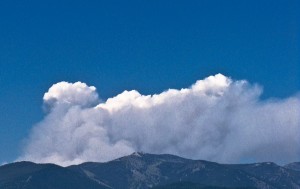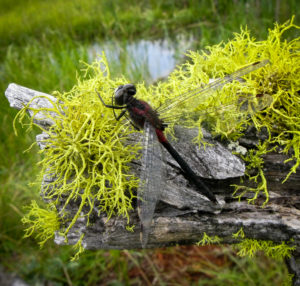Through the darkness
Moon reflects tomorrow’s light
Dreams reflect today’s .
 I have spoken before about the pleasures of cloud spotting. They make every adventure outdoors fill with anticipation to see what might be painted on the canvas of the sky. As Gavin Pretor-Pinney says in The Cloudspotter’s Guide, “I’ve always loved looking at clouds. Nothing in nature rivals their variety and drama; nothing matches their sublime, ephemeral beauty.” And this is nearly always true for me as well. Except when the clouds are ominous. I’m not talking about storm clouds, for I actually love all kinds of weather. But this week there was a cloud on the horizon, rising behind Point Six Mountain where the homestead lies. It is the kind of cloud we are seeing every summer now in the west, one full of dread and worry, the billowing, white topped pyrocumulous.
I have spoken before about the pleasures of cloud spotting. They make every adventure outdoors fill with anticipation to see what might be painted on the canvas of the sky. As Gavin Pretor-Pinney says in The Cloudspotter’s Guide, “I’ve always loved looking at clouds. Nothing in nature rivals their variety and drama; nothing matches their sublime, ephemeral beauty.” And this is nearly always true for me as well. Except when the clouds are ominous. I’m not talking about storm clouds, for I actually love all kinds of weather. But this week there was a cloud on the horizon, rising behind Point Six Mountain where the homestead lies. It is the kind of cloud we are seeing every summer now in the west, one full of dread and worry, the billowing, white topped pyrocumulous.
Pyrocumulous clouds form from the column of air rising from a forest fire. In order to create these clouds, the fire must be large, large enough to create strong convection currents that carry any moisture aloft, where it condenses around the particles in the smoke. Forest fires can thus sometimes create their own weather, complete with thunder and lightening.
This particular cloud was the result of a fire burning up north in the Mission Valley. It grew to a size of 1750 acres and caused the evacuations of 21 homes. Living in the west this has become our new reality. We work to thin our forests and create fire safe zones around our homes. Many of us have given a great deal of thought to what we would take in case we need to evacuate and friends of mine who live deep in the woods pack up their treasures every summer, just so they’ll be ready. It is beginning to change the way we think about what we “own,” and the price we are willing to pay to protect it. The loss of 19 firefighters near Yarnell, Arizona this summer is making us question the whole notion of protecting property as a priority for the fire fighters. Agency reports on the incident question one of the primary priorities being that of protecting property. And yet, lawsuits filed against the land management agencies when property is destroyed in a wildfire makes one ponder where the responsibility actually lies.. Add to that the spiraling costs of fighting fires that threaten all the hundreds of thousands of homes built in the urban-wildland interface in the last twenty years and you have to question who ultimately pays the price for someone’s desire to live “in nature.”
In recent discussions about these very issues I hear people changing the way they think about fire and its seeming inevitability in these times. I know that if a fire should break out up at the homestead, I would not want anyone to risk their lives or expend their resources to “save” my property. I will do the thinning required to reduce the chances of fire. I will remove the beetle- killed trees and do what I can to mitigate their damage. But ultimately I know the land is not really my property. It belongs to the mountain and to the forces of nature.
 The Montana Natural History Center offers an array of Master Naturalist classes. Once you have completed the intial Master Naturalist series, you can continue your education through a yearly offering of specialized topics. Last week I went on a day long field trip to study dragonflies and damselflies. Of course, every time I’m around water in the summer I can’t help but notice these large insects whizzing by and flitting from plant to plant, but I never realized the diversity of what I was seeing. Two or three different colors, the difference in size between a dragonfly and a damsel fly, maybe. But I was astonished to learn that in Montana alone there are 91 different species, 57 dragonflies and 34 damselflies.
The Montana Natural History Center offers an array of Master Naturalist classes. Once you have completed the intial Master Naturalist series, you can continue your education through a yearly offering of specialized topics. Last week I went on a day long field trip to study dragonflies and damselflies. Of course, every time I’m around water in the summer I can’t help but notice these large insects whizzing by and flitting from plant to plant, but I never realized the diversity of what I was seeing. Two or three different colors, the difference in size between a dragonfly and a damsel fly, maybe. But I was astonished to learn that in Montana alone there are 91 different species, 57 dragonflies and 34 damselflies.
Our guides for the trip, Bob Martinka and Nate Kohler are men obsessed with the order, Odonata, which means ones with teeth. This is because these insects are carnivorous, consuming the insects they catch in mid-light by chewing them to mush in their It is one thing to learn the facts about dragonflies, that their eyes have plus or minus 7,000 lenses, or that they have been around for more than 250 million years, predating the dinosaurs, or that their wings, because they are attached to their bodies by separate muscles, can move independently, which means that they can fly backwards as well as forward, upside down, dive, hover, pivot in a circle and fly up to 30 miles per hour.
But information like that is available to anyone with the click of a mouse. What I took away from the field experience was the infectious enthusiasm for Odonatas that our guides demonstrated. They shared how the desire to find and identify different species can send the naturalist out into far-flung wildernesses and hidden potholes and tarns. No book or web page can give you the experience of being in the field with someone who opens up a world of wonder. Reading cannot give you the sense of slogging through a bog, the feel of walking on sponges suspended in water with the possibility of breaking through at any moment. A list of facts cannot substitute for what it’s like to search the insect filled air for a dragonfly or damselfly and the skill to get just the right swipe, with a twist of the wrist to secure them in you net.
I would never have thought it possible to hold a dragonfly in my hand until Bob showed me how to gently grasp their wings between my thumb and forefinger and peer into their multi-faceted eyes. They taught me how to look for all the identifying markings that will tell you what species you are holding.
And then, having caught their infectious curiosity and enthusiasm, I am off on my own, discovering the place in the tall grasses where the tiny sedge sprites are perching, or seeing, as I track them with my net, how the Dancers bounce around, a little spastically, in flight and flick their wings when they perch, giving me that aha moment as I connect their name to their flight pattern. As I spent the day immersed in the Odonata world, I I began to catch a glimpse into the world Leslie Marmon Silko conveys in Ceremony:
“Dragonflies came and hovered over the pool. They were all colors of blue–powdery sky blue, dark night blue, shimmering with almost black iridescent light, and mountain blue. There were stories babout the dragonflies too. He turned. Everywhere he looked, he saw a world made of stories, the long ago, time immemorial stories, as old Grandma called them. It was world alive, always changing and moving, and if you knew where to look, you could see it, sometimes almost imperceptible, like the motion of the stars across the sky.”